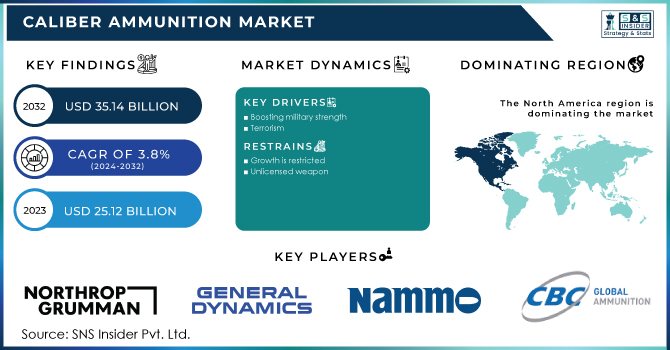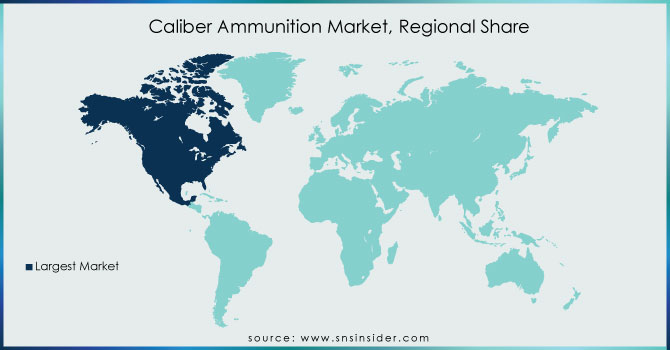Caliber Ammunition Market Report Scope & Overview:

To get more information on Caliber AmmunitionMarket - Request Free Sample Report
The Caliber Ammunition Market size was valued at USD 25.12 billion in 2023 and is expected to reach USD 35.14 billion by 2032, growing at a CAGR of 3.8% over the forecast period of 2024-2032.
Technological advancements for replacing brass-based bullet cases with polymer-based bullet cases are expected to provide market growth opportunities. The use of polymer materials in bullets reduces ammunition weight by more than 40% while maintaining the same impact, making it lighter and more accurate than conventional bullets. Rising geopolitical issues, warlike situations, and increased terrorist activities around the world are causing prominent militaries and armed forces to stockpile more products. This strategy is likely to offer cost savings because the products are purchased in large quantities at low prices, which supports market growth.
Military investments in defense equipment are expected to increase as geopolitical tensions rise around the world, driving product demand. The Indian Army's increased procurement of artillery and mortar platforms through various development platforms is expected to increase the number of ammunition over the forecast period. Furthermore, the increase in hostilities is expected to boost product demand in Middle Eastern countries during the forecast period.
MARKET DYNAMICS
KEY DRIVERS
-
Terrorism
-
War
-
Boosting military strength
RESTRAINTS
-
Growth is restricted
-
Public safety
-
Unlicensed weapon
OPPORTUNITIES
-
Frangible Ammo
-
Green ammunition
-
Modern military technology
-
Lightweight Ammo
CHALLENGES
-
Securities Concerns
-
Faster Manufacturing
THE IMPACT OF COVID-19
The COVID-19 epidemic has had a very small impact on the small arms market as military procurement systems and new generation ammunition have not been affected. The growth of the small grain market depends on a number of factors, such as the allocation of funds for the purchase of new equipment, and is probably adversely affected by the rapid technological advances leading to a shorter service life of new technologies.
Increasing the investment of defense in modern military systems to acquire better tools to replace their existing weapons also serves as one of the main markets driving the small arms market.
Strict gun ownership laws serve as an important obstacle to the growth of the small caliber bullet market during forecasting. Increasing emphasis on gun control measures to reduce gun deaths and injuries, deaths related to domestic violence, homicides, and suicide may also make the process of purchasing licensed firearms more difficult in the future. This is expected to hinder the market growth during forecasting.
KEY MARKET SEGMENTATION
By Application
-
Defense
-
Military
-
Homeland Security
-
Civil & Commercial
-
Sporting
-
Hunting
-
Self-defense
-
Others
By Caliber
-
Small
-
Medium
-
Large
-
Others
By Product
-
Bullets
-
Aerial Bombs
-
Grenades
-
Artillery Shells
-
Mortars
By Component
-
Fuzes & Primers
-
Propellants
-
Bases
-
Projectiles and Warheads
-
Others
By Guidance Mechanism
-
Non-guided
-
Guided
By Lethality
-
Lethal
-
Less-lethal
REGIONAL ANALYSIS
North America is expected to hold the highest share of the global small grain market at the time of forecasting, due to the early adoption of small letters in the region. South America and Middle East Africa have each small market share. However, these regions are expected to provide profitable opportunities in the small grain market during the forecast period. Increased acceptance of various small-scale characters for various military and defense applications is a growing trend in the Asia Pacific. China and India are expected to make a significant contribution to the region's small grain market in the next few years. Increased use of small letters for social and security purposes may drive the small-cap market during the forecast period. This is due to the easy availability and ease of use of low-level characters in programs ranging from sports, hunting, and military objectives.

Need any customization research on Caliber Ammunition Market - Enquiry Now
REGIONAL COVERAGE:
North America
-
USA
-
Canada
-
Mexico
Europe
-
Germany
-
UK
-
France
-
Italy
-
Spain
-
The Netherlands
-
Rest of Europe
Asia-Pacific
-
Japan
-
South Korea
-
China
-
India
-
Australia
-
Rest of Asia-Pacific
The Middle East & Africa
-
Israel
-
UAE
-
South Africa
-
Rest of Middle East & Africa
Latin America
-
Brazil
-
Argentina
-
Rest of Latin America
Key Players
The market for small-caliber coins is divided due to the presence of a few local and international players in the market. Other prominent players in the low-caliber coin market include CBC Global Ammunition, Northrop Grumman Corporation, General Dynamics Corporation, Nammo AS, and Olin Corporation. Many countries produce small ammunition with local production capabilities and small orders are issued to foreign players to meet the shortage of a certain amount of objective ammunition through military systems. For example, Kenya Ordnance Factories Corporation is a local Kenyan manufacturing company that manufactures small arms and related products delivered to Kenyan armed forces, security agencies, and licensed arms dealers. It was exported to the United States. The capacity of the production center is estimated at least 20,000 grains per day. Similarly, INDUMIL, FAMAE, and the Aguila Ammunition are local producers of small letters in Colombia, Chile, and Mexico, respectively, that meet local needs. NATO members and players in NATO countries benefit from the need for ammunition from other NATO members and thus have a sufficient market presence in the military market.
| Report Attributes | Details |
|---|---|
| Market Size in 2023 | US$ 25.12 Billion |
| Market Size by 2032 | US$ 35.14 Billion |
| CAGR | CAGR of 3.8% From 2024 to 2032 |
| Base Year | 2023 |
| Forecast Period | 2024-2032 |
| Historical Data | 2021-2022 |
| Report Scope & Coverage | Market Size, Segments Analysis, Competitive Landscape, Regional Analysis, DROC & SWOT Analysis, Forecast Outlook |
| Key Segments | • by Solution (Hardware, Application Software & Services) • by Platform (Airborne, Land, Naval, Space) • by Application (Command and Control, Communications Computing, Intelligence, Surveillance and Reconnaissance, Electronic Warfare) • by End User (Defense & Space, Homeland Security, Commercial) • by Installation (New Installation, Upgrade) |
| Regional Analysis/Coverage | North America (USA, Canada, Mexico), Europe (Germany, UK, France, Italy, Spain, Netherlands, Rest of Europe), Asia-Pacific (Japan, South Korea, China, India, Australia, Rest of Asia-Pacific), The Middle East & Africa (Israel, UAE, South Africa, Rest of Middle East & Africa), Latin America (Brazil, Argentina, Rest of Latin America) |
| Company Profiles | CBC Global Ammunition, Northrop Grumman Corporation, General Dynamics Corporation, Nammo AS, and Olin Corporation |
| Key Drivers | • Terrorism • War • Boosting military strength |
| RESTRAINTS | • Growth is restricted • Public safety • Unlicensed weapon |

